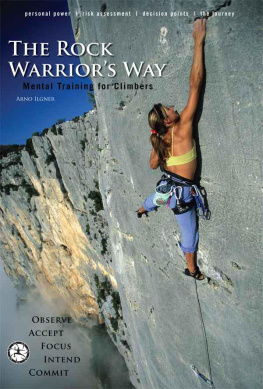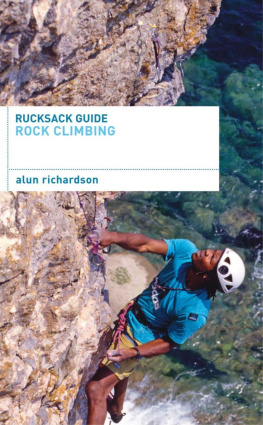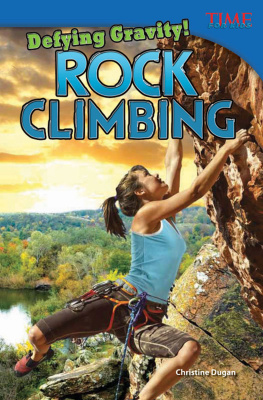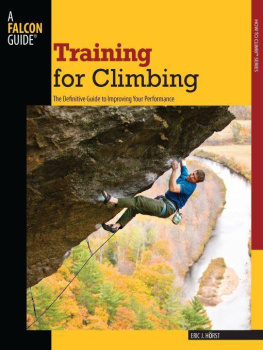

Espresso Lessons From The Rock Warriors Way
Copyright 2009 by Arno Ilgner. All rights reserved. No portion of this book, except for brief passages used in review, may be reproduced in any form without written permission from the publisher.
Published by
Desiderata Institute
315 Oakwood Cove
La Vergne, TN 37086
USA
www.warriorsway.com
Editor: Jeff Achey,
Book design: Tracy Martin,
Library of Congress Cataloging-in-Publication Data
Ilgner, Arno, 1954
Espresso Lessons From The Rock Warriors Way / Arno Ilgner
p. cm.
ISBN 978-0-9740112-3-3
ISBN: 9780974011288
| 1. Rock Climbing 2. TrainingMental | I. Title |
Printed in the United States of America by
Vaughan Printing, Nashville, TN
www.vaughanprinting.com
| First edition; first printing | 10 9 8 7 6 5 4 3 2 1 |
Front Cover Photograph: Andrew Kornylak
Back Cover Photograph: Toni Shurmer
Dedication Page Photograph: Craig Richards 2000, Banff Centre for Mountain Culture and Whyte Museum of the Canadian Rockies, Banff
Photographers: All images are the exclusive copyrighted property
of the photographers. All rights reserved.
Andrew Kornylak: www.akornphoto.com
Benoit Robitaille: www.benoitrobitaille.com
Caroline Treadway: www.carolinetreadway.com
Claire MacLeod: www.rarebreedproductions.co.uk
(Echo Wall DVD can be purchased from www.davemacleod.com)
Cory Richards/C.Richards Photography: www.crichardsphoto.com
Craig Richards:
Greg Barry:
Heinz Zak:
Jimmy Chin: www.jimmychinphotography.com
Lee Tucker:
Pat Goodman:
Tim Steele:
Tom Perkins: www.independencepassrockclimbing.com
I dedicate Espresso Lessons to Todd Skinner.
His vision left a legacy for climbing
we can all aspire to emulate.
But it was his humor and friendliness
that touched those eager to learn.
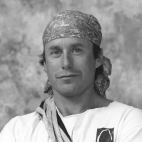
Craig Richards
WE CANNOT LOWER THE MOUNTAIN,
THEREFORE WE MUST ELEVATE OURSELVES.
TODD SKINNER
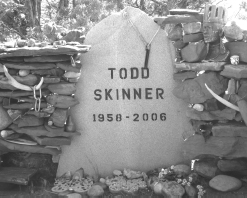
Arno Ilgner Collection
Acknowledgements
I would like to acknowledge and thank these people for their generous help in creating this book. It amazes me how many people it requires to collaborate and create anything. We never create anything in a vacuum.
Editor: Jeff Achey has been amazing in his ability to tighten up what I write. Thanks Jeff for your continued excellence in clarifying what I write and making it more readable.
Book layout: Tracy Martin has done the work on all of the products I have created. Her creativity shows in the final product, which improves the delivery of the material. Thanks Tracy.
Editorial feedback: Suzy Wilkinson and Doyle Parsons gave helpful feedback on content. Rita Bills spent many hours sorting out the grammar and coherence of the text. My wife Jane checked for flow and did a final check. Thank you so much Suzy, Doyle, Rita, and Jane. I really appreciate your unselfish assistance to create this book.
Anvil/Jenn/OMalley Cartoons: I wanted to add some humor and lightness to the material by adding cartoons. Ive known Susan Working since high school. She has always been creative and a talented artist. Thanks Susan for your efforts with this.
Photo models: We did a photo-shoot to collect specific images needed for the book. Thanks to Mark Ilgner, Doyle Parsons, Suzy Wilkinson, Ian Ilgner, Greg Kottkamp, and Yuki McKinney for acting as models.
Photographers: Images help relate the material. Id like to thank these photographers for their beautiful images: Andrew Kornylak, Benoit Robitaille, Caroline Treadway, Claire MacLeod, Cory Richards, Greg Barry, Heinz Zak, Jimmy Chin, Lee Tucker, Pat Goodman, Tim Steele, Tom Perkins and Craig Richards.
Stories: Stories help us learn. Thanks to these people for sharing their stories: Andrea Cutter, Dave MacLeod, Sonnie Trotter, Steph Davis, Jason Kehl and Jean-Pierre Pee Wee Ouellet.
I appreciate using other peoples quotes in this book. Two quotes were taken directly from authors books. Robert Kegan and Lisa Laskows quote in the Introduction comes from their book How the Way We Talk Can Change the Way We Work. Dan Millmans quote in the Preparation chapter comes from his book The Journeys of Socrates.
Lastly, I would like to thank all the students who participated in the Espresso clinics. You have helped me refine and understand the material at a deeper experiential level. Thank you for your feedback. Thank you also for the trust you gave me and to The Warriors Way to add value to your climbing.
Statement of Risk
Climbing involves taking risks and is dangerous. You can never eliminate the risks, only diminish them. There can be a tendency to trust an instructor too much. The same can occur when reading this book. So be skeptical as you read; dont just blindly accept and trust any information. Incorporate what seems appropriate, and what you dont understand, investigate it further. In addition, get instruction from qualified teachers. Ultimately, it is up to you to decide which risks are appropriate. Take full responsibility for how you utilize the information in this book.
Table of Contents
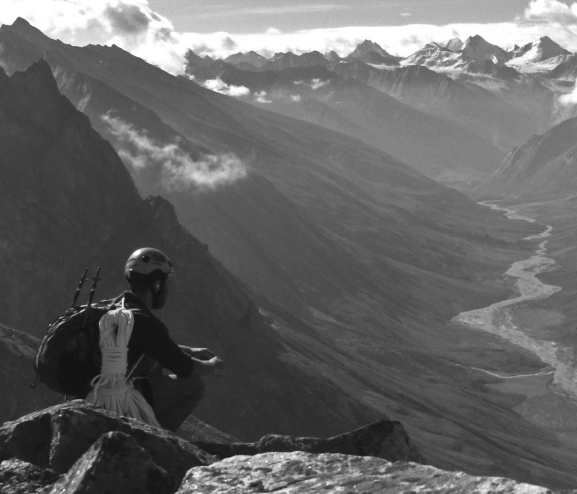
Pat Goodman
TO BRING ABOUT REAL CHANGE WE MUST DISTURB THE BALANCE, OUR STATUS QUO.
ROBERT KEGAN AND LISA LASKOW
Introduction
In 2003 I published The Rock Warriors Way, which outlines the foundational processes of the Warriors Way material. The warrior is an archetype for courage. A warrior must act courageously, with impeccable awareness, in order to fight well. Impeccable awareness simply means that attention is in the present moment and not distracted. Mental fitness training is simply improving our ability to keep attention in the moment, on the current task, allowing us to learn and grow. This is the foundation for developing mental fitness and the warriors way.
We tend to equate a powerful mind with being mentally fit, but this is really a misunderstanding of mental fitness. In fact, our minds will tend to limit us at every turn and drain our power away. We need to get out of our minds to see situations more clearly. Mental fitness is not concerned with the mind, per se, but rather with awareness. Someone who is mentally fit is aware. With awareness we dont fall victim to the minds limiting tendencies that rule us if we lack mental fitness.
Questioning your mind can develop awareness. What can I control? What cant I control? Can I think positively to become mentally fit? What is an appropriate risk? Why am I afraid of falling? Should I practice falling to overcome that fear? Answering questions such as these will begin to reveal limiting tendencies in your mind. Understanding these tendencies will allow you to utilize the intelligence that your mind does have, instead of falling victim to its limitations. After developing awareness by asking such questions, you can take intentional actions to improve your mental fitness.
Since
Next page

